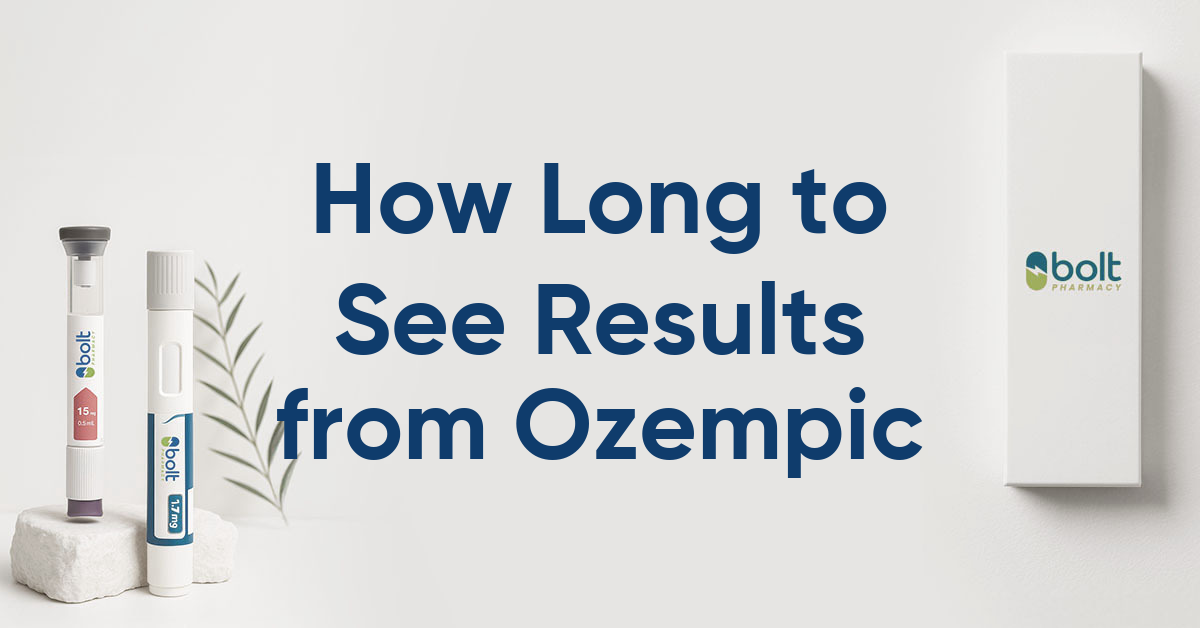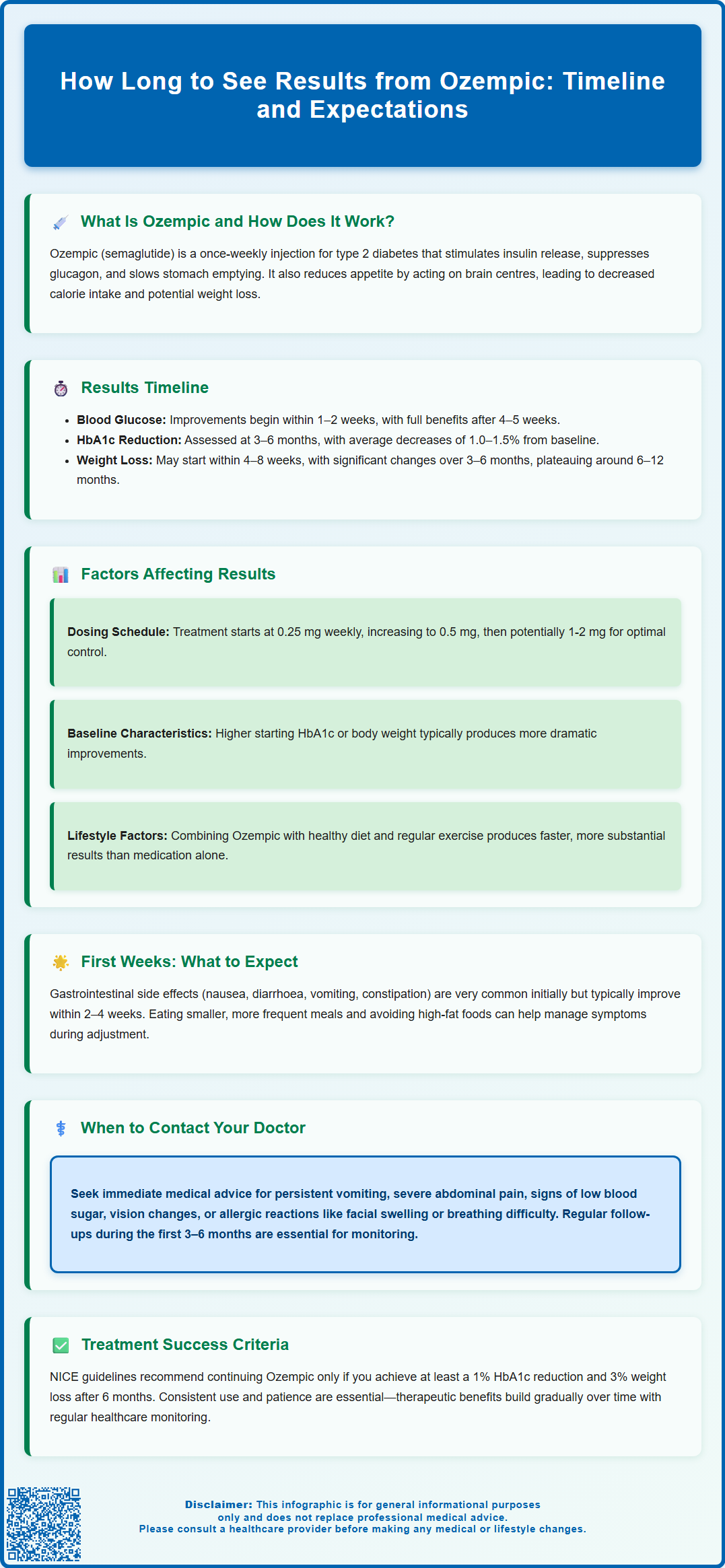Mounjaro®
Dual-agonist support that helps curb appetite, hunger, and cravings to drive substantial, sustained weight loss.
- ~22.5% average body weight loss
- Significant weight reduction
- Improves blood sugar levels
- Clinically proven weight loss

Many patients starting Ozempic (semaglutide) for type 2 diabetes wonder how long it will take to see improvements in their blood glucose levels and overall health. Ozempic is a once-weekly GLP-1 receptor agonist that works by enhancing insulin secretion, suppressing glucagon, and slowing gastric emptying. Whilst some effects begin within days, the full therapeutic benefits typically emerge over several weeks to months. Understanding realistic timelines for blood glucose control and other outcomes can help you stay motivated and work effectively with your healthcare team. This article explains what to expect during treatment and the factors that influence how quickly Ozempic works.
Summary: Blood glucose improvements from Ozempic typically begin within 1–2 weeks, with full glycaemic benefit apparent after 4–5 weeks at a stable maintenance dose.
Ozempic (semaglutide) is a prescription medicine licensed in the UK for the treatment of type 2 diabetes mellitus in adults as an adjunct to diet and exercise. It belongs to a class of medications called glucagon-like peptide-1 (GLP-1) receptor agonists, which mimic the action of a naturally occurring hormone that helps regulate blood glucose levels. Importantly, Ozempic is not indicated for type 1 diabetes or for the treatment of diabetic ketoacidosis.
The mechanism of action of Ozempic is multifaceted. When administered, semaglutide binds to GLP-1 receptors in the pancreas, stimulating insulin secretion in a glucose-dependent manner—meaning it only works when blood sugar levels are elevated. Simultaneously, it suppresses glucagon release, a hormone that raises blood glucose. This dual action helps maintain more stable glycaemic control throughout the day.
Beyond its effects on pancreatic hormones, Ozempic also slows gastric emptying, which means food moves more slowly from the stomach into the small intestine. This contributes to improved post-meal glucose levels and promotes a feeling of fullness, which may lead to reduced calorie intake. Additionally, semaglutide acts on appetite centres in the brain, helping to reduce hunger and food cravings.
Ozempic is administered as a once-weekly subcutaneous injection using a pre-filled pen device. It should be taken on the same day each week, with or without food, and injection sites (abdomen, thigh, or upper arm) should be rotated. The pen is for personal use only and should never be shared. Ozempic is available in different dose strengths (0.25 mg, 0.5 mg, 1 mg, and 2 mg), with treatment typically starting at a lower dose and gradually increasing to minimise gastrointestinal side effects.
Women who are pregnant, breastfeeding, or planning pregnancy should not use Ozempic. The medication should be discontinued at least 2 months before a planned pregnancy due to the potential risk to the developing foetus.
The timeframe for seeing results from Ozempic varies depending on what outcomes you are measuring—blood glucose control or weight loss—and individual patient factors. Understanding these timelines can help set realistic expectations and support adherence to treatment.
Blood glucose improvements typically begin within the first few days to weeks of starting Ozempic. Many patients notice better fasting glucose readings and reduced post-meal spikes within 1–2 weeks of initiating therapy. However, the full glycaemic benefit usually becomes apparent after 4–5 weeks of treatment at a stable maintenance dose. This is because semaglutide reaches steady-state concentrations in the bloodstream after approximately 4–5 weeks of once-weekly dosing at the same dose level.
Clinical trials have demonstrated that HbA1c reductions—a key marker of long-term glucose control—are typically assessed at 3–6 months after starting treatment, in line with NICE guidance for monitoring. Patients in clinical studies (SUSTAIN programme) experienced average HbA1c reductions of 11–16 mmol/mol (1.0–1.5%) from baseline, with greater reductions generally seen at higher doses (1 mg and 2 mg), though individual responses vary.
Weight loss, whilst not the primary licensed indication in the UK for Ozempic, is a commonly observed effect. Patients may begin to notice modest weight reduction within 4–8 weeks, with more substantial changes typically occurring over 3–6 months of continued therapy. The weight loss effect tends to plateau after approximately 6–12 months, though this varies considerably between individuals.
According to NICE guidelines, GLP-1 receptor agonists like Ozempic should be continued only if there is a beneficial metabolic response at 6 months, defined as a reduction in HbA1c of at least 11 mmol/mol (1%) and weight loss of at least 3% from initial body weight.
It is important to note that Ozempic is not a rapid-acting medication. Patience and consistent use are essential, as the therapeutic benefits accumulate gradually over time. Regular monitoring by your healthcare team will help track progress and adjust treatment as needed.

Several factors influence how quickly and effectively Ozempic produces results, and understanding these can help explain individual variation in treatment response.
Dosage and titration schedule play a crucial role. Ozempic treatment typically begins with a starting dose of 0.25 mg once weekly for the first 4 weeks, which serves primarily as a dose escalation step to improve gastrointestinal tolerability rather than for glycaemic efficacy. The dose is then increased to 0.5 mg weekly, and may be further increased to 1 mg or 2 mg weekly if additional glucose control is needed. Patients on higher maintenance doses generally experience greater HbA1c reductions and weight loss, though this must be balanced against the increased risk of side effects.
Baseline characteristics significantly affect outcomes. Individuals with higher starting HbA1c levels often see more dramatic absolute reductions, whilst those with HbA1c closer to target may experience smaller numerical changes. Similarly, patients with higher body weight at baseline tend to lose more absolute weight, though percentage weight loss may be comparable across different starting weights.
Adherence to treatment is fundamental. Missing doses or inconsistent administration can delay or diminish therapeutic effects. Because Ozempic has a long half-life (approximately 1 week), occasional missed doses may not immediately compromise glucose control, but regular non-adherence will reduce efficacy.
Lifestyle factors including diet, physical activity, sleep quality, and stress management all influence how well Ozempic works. The medication is most effective when combined with appropriate nutritional choices and regular exercise, as recommended in NICE guidelines for type 2 diabetes management. Patients who make concurrent lifestyle modifications typically see faster and more substantial improvements.
Concomitant medications may also affect response. While Ozempic has a low potential for clinically relevant drug interactions, the main concern is an increased risk of hypoglycaemia when used with insulin or sulfonylureas. Your healthcare provider may need to reduce the doses of these medications when starting Ozempic to minimise this risk.
Patients should maintain adequate fluid intake, particularly if experiencing gastrointestinal side effects, as dehydration could potentially lead to acute kidney injury in severe cases. No dose adjustment is needed for patients with renal impairment, but closer monitoring may be advised.
Starting Ozempic requires preparation and awareness of what to expect during the initial treatment period. Understanding common experiences can help you manage the adjustment phase more effectively.
Gastrointestinal side effects are the most frequently reported adverse reactions during the first weeks of treatment. These may include:
Nausea (very common, affecting more than 1 in 10 people)
Diarrhoea (very common)
Vomiting (common)
Constipation (common)
Abdominal pain or bloating (common)
Reduced appetite (common)
These symptoms are typically mild to moderate and tend to improve over 2–4 weeks as your body adjusts to the medication. The gradual dose escalation schedule is specifically designed to minimise these effects. Eating smaller, more frequent meals and avoiding high-fat foods can help manage gastrointestinal symptoms.
Injection site reactions such as mild redness, itching, or bruising may occur but are usually minor and resolve quickly. Rotating injection sites (abdomen, thigh, or upper arm) can help prevent localised reactions.
During the first month, you may notice subtle changes in appetite and eating patterns before seeing significant changes on the scales or in glucose readings. Some patients report feeling fuller sooner during meals or experiencing fewer cravings between meals.
If you miss a dose, take it as soon as possible within 5 days after the missed dose. If more than 5 days have passed, skip the missed dose and take your next dose on the regularly scheduled day. Do not take a double dose to make up for a missed dose.
When to contact your GP or diabetes care team:
Persistent or severe nausea and vomiting that prevents adequate fluid intake
Severe abdominal pain, particularly if accompanied by back pain (potential pancreatitis)
Signs of hypoglycaemia (if taking Ozempic with insulin or sulphonylureas)
Symptoms of dehydration
Changes in vision, particularly if you have pre-existing diabetic retinopathy
Right upper abdominal pain, fever, or yellowing of the skin/eyes (possible gallbladder problems)
Swelling of the face, lips, tongue, or throat, or difficulty breathing (possible allergic reaction)
Regular follow-up appointments are essential during the first 3–6 months to monitor HbA1c, assess tolerability, adjust dosing, and provide ongoing support. Your healthcare team will work with you to optimise treatment and address any concerns that arise during this important initiation period.
If you experience any side effects, talk to your doctor, pharmacist or nurse. This includes any possible side effects not listed above. You can also report side effects directly via the Yellow Card Scheme at yellowcard.mhra.gov.uk.
Most patients notice better fasting glucose readings and reduced post-meal spikes within 1–2 weeks of starting Ozempic. The full glycaemic benefit typically becomes apparent after 4–5 weeks of treatment at a stable maintenance dose, as this is when semaglutide reaches steady-state concentrations in the bloodstream.
Ozempic reaches its full effectiveness after approximately 4–5 weeks at a stable dose. However, HbA1c reductions—the key marker of long-term glucose control—are typically assessed at 3–6 months after starting treatment, in line with NICE guidance for monitoring type 2 diabetes medications.
If you haven't noticed improvements after 4–6 weeks, contact your diabetes care team. They may need to adjust your dose, review your adherence to treatment, assess lifestyle factors, or consider whether Ozempic is the most appropriate medication for you. NICE guidelines recommend evaluating treatment response at 6 months to determine whether to continue therapy.
The health-related content published on this site is based on credible scientific sources and is periodically reviewed to ensure accuracy and relevance. Although we aim to reflect the most current medical knowledge, the material is meant for general education and awareness only.
The information on this site is not a substitute for professional medical advice. For any health concerns, please speak with a qualified medical professional. By using this information, you acknowledge responsibility for any decisions made and understand we are not liable for any consequences that may result.
Lorem ipsum dolor sit amet, consectetur adipiscing elit, sed do eiusmod tempor incididunt ut labore et dolore magna aliqua. Ut enim ad minim veniam, quis nostrud exercitation ullamco laboris nisi ut aliquip ex ea commodo consequat. Duis aute irure dolor in reprehenderit in voluptate velit esse cillum dolore eu fugiat nulla pariatur.
Block quote
Ordered list
Unordered list
Bold text
Emphasis
Superscript
Subscript